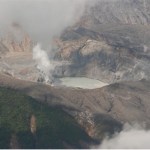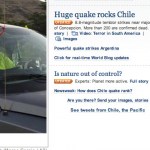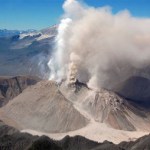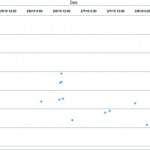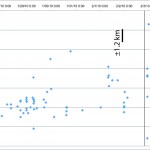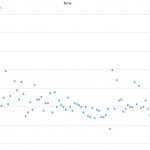seismicity
A shot from the Hekla webcam showing the glow from the eruption of Eyjafjallajökull that started March 20, 2010.
Quick note, but for those of you who have been following the seismicity at Eyjafjallajökull in Iceland, there is news from Iceland that an eruption has started. I will post more details as I can find them, but so far, evacuations have commenced near the volcano. It sounds like the eruption can be seen coming through the glacier on the volcano, but any real details of the style of volcanism are unknown. This is the first known eruption of Eyjafjallajökull since 1823.
UPDATE 9:40…
Leaving for Death Valley tomorrow - I'll be sure to take some pictures of Ubehebe Crater and the volcano at the Mirage. This will likely be the last new post until about a week from now, but look for the Erta'Ale Volcano Profile, maybe a new Mystery Volcano Photo and I'll leave a thread open for any new volcano news.
Colima in Mexico.
Eruptions reader Tim Stone sent me this image from Japanese astronaut Soichi Noguchi's Twitpic feed - it is a stunner of the caldera on Jebel Marra in Sudan. The only known historical eruption for this volcano was ~2000 BC within the Deriba Caldera, but it has…
Did I mention its a busy week?
The lava lake at Erta'Ale in 2008. Image courtesy of Stromboli Online.
Our Icelandic saga continues, with more earthquakes and more speculation/information on the parts of Eruptions readers. Keep up the discussion - I'll be fascinated to see who turns out to get closest to what actually happens, prediction-wise. The seismicity has quieted somewhat again in the last 12 hours, so we wait eagerly to see what comes next. Remember, Iceland is the land where volcanoes helped change history, so it is always fun to talk Icelandic volcanism.
The NASA Earth Observatory…
Eyjafjallajökull, an ice-capped volcano in Iceland that last erupted in 1823.
We talked a few weeks ago of signs that there were increasing signs that an eruption could occur on Iceland - increased seismicity on the Reykjanes Ridge suggested that magma might be on the move. Now, we have two pieces of evidence that we might see activity at Eyjafjallajökull, on the southern side of the island nation.
First off, there is a focus of seismicity under the area of Eyjafjallajökull, with an especially large bump in the last 2 days. Both the number and magnitude of the seismicity has been marching…
Some news for a busy Tuesday:
The crater at Poas volcano in Costa Rica, taken February 25, 2010. Image courtesy of OVSICORI by Federico Chavarria.
After the MSNBC debacle, it is nice to see some good articles on why the Chilean earthquake was overall less disastrous than the Haitian earthquake, why the tsunami wasn't as large as predicted and why these earthquakes are not abnormal. There are a lot of factors involved - the location, depth, preparedness, wealth - so the comparison can be very telling in terms of both geologic and societal issues.
The other scientific fallout from the Chilean…
News!
Toba caldera in Indonesia.
We're all still talking about the Chilean earthquake and the coverage of the event. If you happen to live in the Columbus area, you might have heard me on WTVN talking about the earthquake as well.
The Toba (Indonesia) eruption 74,000 years ago has been used by some researchers to be the cause of a "genetic bottleneck" for humans - however, that is still much debated. Currently, excavations are under away near Toba to look for evidence of human habitation that was buried by the eruption. The evidence of stone tools that appear to be made by the same human…
Screen capture of the MSNBC website on February 27, 2010 at ~5:30 PM eastern time.
Most of you have probably already heard about the magnitude 8.8 earthquake that struck today off the coast of Chile. This becomes one of the most powerful earthquakes on record and so far, the death toll has been relatively low - in the hundreds - especially compared to the horrific disaster of the Haiti earthquake from earlier this year. My thoughts go out to all in Chile recovering from the earthquake.
However, I am a little appalled at some of the coverage I've seen for this earthquake. MSNBC has become the…
The flu has retreated and I'm getting back on track. Huzzah!
I'll get back to the blog by posting this week's new USGS / Smithsonian Institution Global Volcanism Program Weekly Volcano Report. Looks like some interesting stuff in it ...
Looks like there were some small eruptions from Oldoinyo Lengai in Tanzania. The volcano is one of the few (only active?) carbonatite volcanoes in the world, erupting a lava composed primarily of calcium carbonate and sodium minerals with very little silica. It leads to the odd lava that erupt black (and cool ~ 500C) and cool to white, making it one of the…
The Icelandic coast of Reykjanes where the Mid-Atlantic Ridge comes above sea level.
A number of Eruptions readers have noticed that seismicity along the Reykjanes Ridge that runs to the southwest of Iceland onto the island has increased over the last few days. Sure enough, checking the Icelandic Met Office page on seismicity on the island finds a lot of earthquakes on the southwest peninsula that is the manifestation of the Mid-Atlantic Ridge hitting the hotspot-related Icelandic landmass. The interaction between the Iceland plume and the Mid-Atlantic Ridge is complex, with a step in the…
The rhyolite domes of Chaiten in Chile in an undated photo. Note how much of the previous Chaiten Caldera has already been filled by the new domes that started after Chaiten erupted in May 2008.
CNN International has a report that the National Emergency Office (ONEMI) in Chile has reinforced the "red alert" status of Chaiten (spanish). The volcano, which has been erupting since May 2008, had recently settled down to slow, but constant, dome growth. However, over the last 3 weeks, seismicity has been increasing at the rhyolite caldera, suggesting that we might be heading towards an upswing of…
The Great Earthquake Swarm at Yellowstone that ushered in 2010 seems to be dying down, at least according to the USGS earthquake reports and analysis of the seismicity by the University of Utah and YVO. The daily updates on the earthquake swarms by Utah has ended. Looking at the earthquake over the last 7 days (see below), you can notice three things quickly: (1) since 2/6, there are much fewer quakes compared to a week and a half ago; (2) any sign the earthquakes were getting shallower seems to have ended; and (3) they seem to be generally smaller ( M1.5). Now, what does that mean? Like many…
News!
Pakistan is home to the world's tallest mud volcano in the region of Balochistan - and its somewhat near the reports of an "eruption" earlier this week.
Guess what? Since Wednesday evening, seismicity at Yellowstone has dropped precipitously. The last batch of earthquakes on February 3rd were also back to deeper levels - 8-9 km depth - compared to the potential shallowing earlier in the week. I'm sure the caldera will keep us on our toes, but as of now, it seems to have settled down a bit.
Over in Pakistan, there is mounting evidence that the recent "volcanic" eruption reported as, in…
A 2010 mud flow from Lok-Batan, a mud volcano in Azerbijian.
So, first there was all the Yellowstone talk. Then the unsubstantiated reports of a volcanic eruption in a decidedly unvolcanic part of Pakistan (what part isn't), then submarine volcanism off Japan. Now, we have a nrews report about an eruption in Azerbijian. Luckily, although the headline implies a magmatic event, the text of the article shows that this is, in fact, a mud volcano. The mud volcano is called Lok-batan (or Lokbata) and has erupted quite a few times over the last 150 years, as recently as 2005. Azerbijian has quite a…
With all the talk of the current Yellowstone earthquake swarm, I thought it would worth it to write a post on the the structure and caldera - and why we get earthquake swarms that are structurally rather than magmatically-related.
First off, lets think about why calderas formed. This is relatively simple - at least superficially. The land (or volcano) above a magmatic system is partially supported by that magma, especially because magma is hot and buoyant. The isostatic support by the magma holds up the land surface or volcanic edifice, so when an eruption expels a large volume of magma, this…
Steaming, gurgling mudpots in the active hydrothermal system of Yellowstone.
For those of you following Yellowstone (I think there might be a few of you), I've plotted up the earthquakes since 1/27 (see below) - and sure enough, although there is a lot of scatter, they are getting shallower - however what this exactly means is unclear. You can see my plots from 1/22-28 here. As many of you have mentioned, a caldera like Yellowstone is a big interconnected system, so a solely tectonic source of this is still possible as the displacement migrates through the fractured caldera rocks.
UPDATED…
Tungurahua erupting in an undated AP photo (although I think it is the current 2010 activity.)
It hasn't really made it to much of the English-speaking news, but the current eruptive activity at Tungurahua appears to be on the up-tick. Hugo Yepes of the Geophysical Institute of Ecuador suggests that a larger eruption is not out of the question (link in spanish), but right now the activity is confined to explosions (vulcanian?) and ash fall around the region, specifically on Pillates and Choglontus overnight (2/1) from the ~ 2 km / 5 000 foot plume. Looking at the specifics (link in spanish…
There has been a ... ahem ... healthy discussion of Yellowstone's current earthquake swarm on Eruptions as of late. We've now reached ~1,500 measurable earthquakes over the last 11 days. The latest reports of the continuation of the swarm isn't going to make anyone happy, but still, there are no signs that (a) this is out of the ordinary and (b) indicates magma making its way to the surface. In fact, if you plot the earthquakes since the 22nd of January, the depth appears to getting, well, deeper:
This plot shows the earthquakes listed on the USGS earthquake page since January 22 (oldest to…
Old Faithful geyser at Yellowstone National Park.
A few thoughts about faulting, earthquakes and eruptions:
The earthquakes at Yellowstone have been universally attributed to fault movement rather than magmatic activity by the USGS and the researchers at the University of Utah. This is likely based on the moment solutions for the earthquakes (i.e., the sense of motion on the earthquake - side to side, dilation, etc.) and the fact that there are no directly correlative volcanic/magmatic symptoms to go with them (such as pronounced, short-term bulging, excessive hydrothermal venting, etc.) Now…
Two quick notes:
A Costa Rican farmer evacuating in early January 2010 after renewed activity of Volcan Turrialba.
Well, it appears that after a quiet night on Friday, the current Yellowstone swarm picked up where it left off. We're now up to 1,200 earthquakes since January 17th, with a pair over M3 today. Of course, people are still uppity about the swarm, especially after the earthquake in Haiti, but really, they're about as connected as worrying about the rainy day in Boston when there was a typhoon in Malaysia. Just to get people on the same page, YVO still says: "The swarm events are…
Outcrops of Obsidian Butte, California, near the Salton Sea.
A brief update on the two earthquake swarms making news right now:
Yellowstone
The earthquake swarm at Yellowstone is still rumbling along, reaching over 1,000 earthquakes measured over the last week. However, the swarm has begun to die down overnight - with no earthquakes between 10:41 PM (MST) on 1/22 and 6 AM on 1/23. However, although this is a longer, bigger swarm than normal, it still isn't out of the regular rumblings at Yellowstone caldera. The USGS continues to say this swarm is tectonic, rather than magmatic or…
